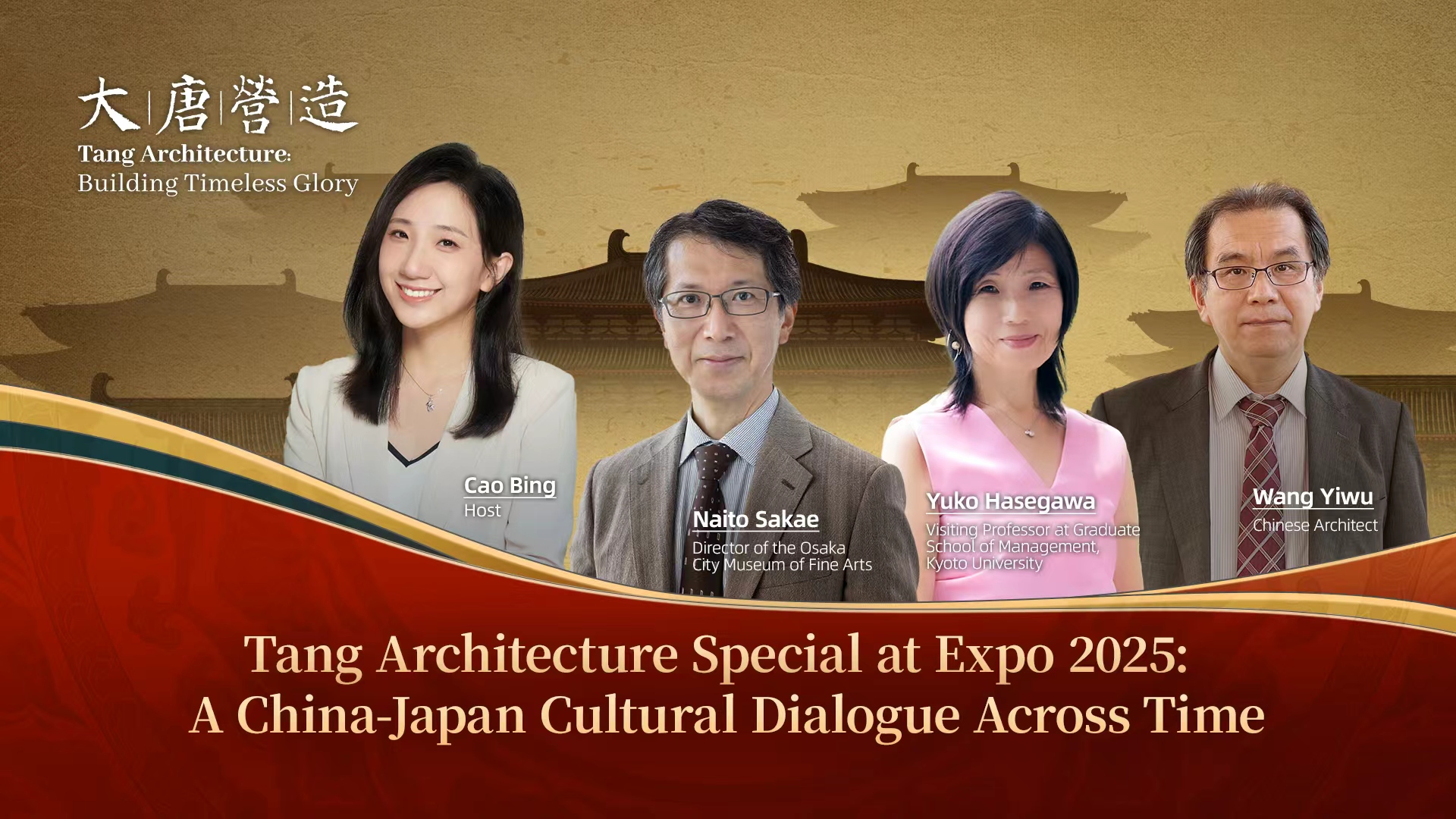By continuing to browse our site you agree to our use of cookies, revised Privacy Policy and Terms of Use. You can change your cookie settings through your browser.
Watch: CGTN dialogue at Expo 2025 opens new channel for China-Japan exchange
A dialogue on China-Japan cultural exchange and the global expression of Chinese aesthetics is taking place at the China Pavilion at Expo 2025 in Osaka, Japan.
Chinese and Japanese experts in the fields of architecture and culture discuss cultural cooperation and exchange. Guest speakers include Yuko Hasegawa, visiting professor at Kyoto University; Naito Sakae, curator of the Osaka City Museum of Fine Arts; and Chinese architect Wang Yiwu.
The dialogue is part of a CGTN event that includes the launch of the Japanese edition of "Tang Architecture: Building Timeless Glory," the third season of the CGTN Art Series.
This interactive digital exhibition highlights the beauty of architectural marvels made during the Tang Dynasty (618-907) and immerses viewers in the aesthetics of that golden age. It brings to life wooden structures that profoundly influenced global design and are revered as the pinnacle of ancient Chinese architecture. In this way, it opens a new window for people to explore traditional Chinese art and culture.
CHOOSE YOUR LANGUAGE
- Albanian Shqip
- Arabic العربية
- Belarusian Беларуская
- Bengali বাংলা
- Bulgarian Български
- Cambodian ខ្មែរ
- Croatian Hrvatski
- Czech Český
- English English
- Esperanto Esperanto
- Filipino Filipino
- French Français
- German Deutsch
- Greek Ελληνικά
- Hausa Hausa
- Hebrew עברית
- Hungarian Magyar
- Hindi हिन्दी
- Indonesian Bahasa Indonesia
- Italian Italiano
- Japanese 日本語
- Korean 한국어
- Lao ລາວ
- Malay Bahasa Melayu
- Mongolian Монгол
- Myanmar မြန်မာဘာသာ
- Nepali नेपाली
- Persian فارسی
- Polish Polski
- Portuguese Português
- Pashto پښتو
- Romanian Română
- Russian Русский
- Serbian Српски
- Sinhalese සිංහල
- Spanish Español
- Swahili Kiswahili
- Tamil தமிழ்
- Thai ไทย
- Turkish Türkçe
- Ukrainian Українська
- Urdu اردو
- Vietnamese Tiếng Việt
CHOOSE YOUR LANGUAGE
- Albanian Shqip
- Arabic العربية
- Belarusian Беларуская
- Bengali বাংলা
- Bulgarian Български
- Cambodian ខ្មែរ
- Croatian Hrvatski
- Czech Český
- English English
- Esperanto Esperanto
- Filipino Filipino
- French Français
- German Deutsch
- Greek Ελληνικά
- Hausa Hausa
- Hebrew עברית
- Hungarian Magyar
- Hindi हिन्दी
- Indonesian Bahasa Indonesia
- Italian Italiano
- Japanese 日本語
- Korean 한국어
- Lao ລາວ
- Malay Bahasa Melayu
- Mongolian Монгол
- Myanmar မြန်မာဘာသာ
- Nepali नेपाली
- Persian فارسی
- Polish Polski
- Portuguese Português
- Pashto پښتو
- Romanian Română
- Russian Русский
- Serbian Српски
- Sinhalese සිංහල
- Spanish Español
- Swahili Kiswahili
- Tamil தமிழ்
- Thai ไทย
- Turkish Türkçe
- Ukrainian Українська
- Urdu اردو
- Vietnamese Tiếng Việt
互联网新闻信息许可证10120180008
Disinformation report hotline: 010-85061466



A dialogue on China-Japan cultural exchange and the global expression of Chinese aesthetics is taking place at the China Pavilion at Expo 2025 in Osaka, Japan.
Chinese and Japanese experts in the fields of architecture and culture discuss cultural cooperation and exchange. Guest speakers include Yuko Hasegawa, visiting professor at Kyoto University; Naito Sakae, curator of the Osaka City Museum of Fine Arts; and Chinese architect Wang Yiwu.
The dialogue is part of a CGTN event that includes the launch of the Japanese edition of "Tang Architecture: Building Timeless Glory," the third season of the CGTN Art Series.
This interactive digital exhibition highlights the beauty of architectural marvels made during the Tang Dynasty (618-907) and immerses viewers in the aesthetics of that golden age. It brings to life wooden structures that profoundly influenced global design and are revered as the pinnacle of ancient Chinese architecture. In this way, it opens a new window for people to explore traditional Chinese art and culture.